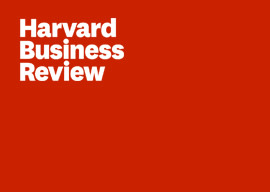
John Geraci's description of his time at the New York Times, striving to bring innovation to a prestigious, top-of-its-game news organization, is such a clear and telling window into the world of corporate change. The themes he describes, following the pendulum shifts as innovation moves from a theory to a possibility to a reality, are ones I’ve seen many times as an innovation design consultant to a slew of big companies trying to act a bit smaller.
Geraci’s characterization of the Ecosystem Mindset is an elegant one. The analogy works well in describing the modern, adaptive organization and the ways in which innovation occurs at clip and with impact.
Here's how to transform a veteran group of category experts into a living, breathing, evolving network of change.
While his call to arms is rousing, he left us with little to pick up. Yes, Geraci describes the ethos and attitudes of an ecosystem-minded organization, but he does little to help us to understand what it takes to build such an institution, and how to transform a veteran group of category experts into a living, breathing, evolving network of change.
Building upon Geraci’s piece, I’d like to suggest a few themes to organizations seeking to adopt this Ecosystem Mindset:
Rid Yourself of the “Not Made Here” Syndrome
There is a belief, often engrained in large corporations, that change comes from the inside. Indeed, in the Times’s own innovation report from 2014, it lists a team of insiders: journalists, columnists, digital designers with impeccable credentials… as journalists, columnists, digital designers. It can be difficult to stare at the hard truths, let alone to disrupt them, when they are directly tied to your livelihood, your career, your byline.
And yet, innovators learn time and again to forgive ourselves the need to be creators, to shamelessly beg, borrow or steal good ideas when we see them. Examples abound: Steve Jobs loved to riff on Picasso’s quote: “Good artists copy, great artists steal,” adding “We have always been shameless about stealing great ideas.” Apple lore includes the (sometimes contested) story of Jobs visiting Xerox PARC and discovering such interactive breakthroughs as the mouse and on-screen windows—technologies whose potential the inventors had not fully realized, but that Jobs could see as relevant to users. Or look to Edison, who R&D’d the lightbulb to be market-ready…built off of a Canadian patent for an early version. The innovation value is as much in recognizing a great idea and in bringing it into a consumer-friendly system as it is in the creation of it.
Innovators learn time and again to forgive ourselves the need to be creators, to shamelessly beg, borrow or steal good ideas when we see them.
Some of the Times’ biggest challengers have no qualms about inventorship. While I don’t mean to suggest that the Times should become a news aggregator with belly-fat-reduction advertisements running on the side-bar, I do think the organization should consider what its “core technology” is and where it can and should feel comfortable appropriating from others to enhance this.
Ignore the Appeal of the New
Similarly, there is this persistent notion that innovation is about the new. We love to think about innovation as the flying car, the jetpack. But the name of the game isn’t about novelty, it’s about resonance. The goal is, as Geraci mentions, growth—and innovation is merely one means towards that goal.
It can be alluring to talk about the advantages of start-ups, with no infrastructural, organizational or emotional baggage. But I’d like to credit for a moment the behemoths, those organizations who have spent decades building, protecting, and enhancing their offers, brands, relationships with consumers, and purpose. The innovation chatter around these organizations is so often about things like building “beyond the core,” or thinking like entrepreneurs, or even the stunningly corporate linguistics of “intrapreneurship.” Distracted by the new, they sometimes forget the benefit of concurrently diving deep into their heritage, nurturing long-held relationships, or reexamining core products.
Innovation is as much about drafting off of existing ideas, capitalizing on trends, and assembling experience systems as it is about the need to create the new. Recall that some of our old favorites were smart samplers as much as inventors, from Gutenberg bringing technology from the wine press to create the printing press to the Wright Brothers inspiration from flight experiments by earlier enthusiasts. Creative superstars have been remixing ideas since yore: consider James Joyce picking up The Odyssey, recasting it with the themes, characters, spaces, and language of his time (or really, to give Joyce his due, ahead of his time), and creating Ulysses.
And the current media landscape bears this out, with old-timey models like long-from radio pieces (distributed today as podcasts), serialized material (written and podcast alike) and contemporary soap operas (from Girls to Downton Abbey) rallying “attention minutes” (as we say in the vernacular) for journalism, storytelling, and robust content.
Look Beyond Your Ecosystem
Perhaps less relevant for Andreessen Horowitz, but essential for the Times, is the recognition that the ecosystem is not only about expanding the network of an organization, but about understanding that of its users. Media reporting these days can feel like a hurricane of damning realities: dropping revenues, falling readership, flighty attention spans. Can we call Vice a news organization? Is Buzzfeed?
If I were at the Times, I’d want to sit down in the homes of my readers, ride the train to work with them, watch how they skim my carefully crafted pieces as a distraction at work.
Companies in threatened categories can get really self-centered, and who can blame them when they feel pressured from so many directions. But if they step back from a defensive stance, they can consider that their shaky landscape is actually a reflection of the needs and preference of the user. It’s not about the competitor; it’s about the reader.
Yes, technology enables changes; news organizations are capitalizing on these. And yet, at the core, readers need to be there to engage. Understanding the people who actually sit at the hub of all this change means taking a deep dive into the worlds of consumers. After all, as much as it can feel like we are at the center of the fray, in our silver skyscrapers, managing massive budgets and declaring truths at global scale, it is in fact the consumer who is at the heart of it all. In the news game especially, the product exists in a vacuum without a reader. What is the purpose of reporting if there is no one to receive it? Does it matter what Trump said last Tuesday if no one were to read about it?
By understanding the ecosystem of its users, an organization like the Times can better understand where it can and should fit in that system—and recraft its own accordingly. As an example, Continuum did this recently with Fisher-Price, looking closely at what tomorrow’s parents will value and how their kids will play so that we could imagine a future that takes the company well beyond plastic toys to tech-enabled immersive and personalized experiences.
And so if I were at the Times, I’d want to sit down in the homes of my readers, ride the train to work with them, watch how they skim my carefully crafted pieces as a distraction at work. I’d want to see how they are using sources that I’d probably never consider “reporting”: their Twitter feed, what’s happening on Snapchat, the bloggers whose personal lives, recipes, or clothing choices they may follow. I’d want to know where they get information, what they pay for and don’t, how they use it and why. I’d want to know who they are, not just who they are in relation to my organization, so that I could imagine how my ecosystem and their ecosystem could become more symbiotic.
This might mean that how I define news shifts, say, from an historic emphasis on “breaking” it to a more curatorial role. When information is a commodity, does the paper’s role shift to analysis, interpretation, or even outsourced taste-making? It might mean I recognize that there is the need for filters, not completeness, or that sometimes a reader wants to be told what to think, to outsource the synthesis—but from someone she trusts. Is that still the role of a news organization? Does the Times have the right to redefine news?
System = Interactions
There are ossified boundaries inside every organization, and some of the most profound impact can come from recognizing and rethinking them. At the most fundamental level, functional silos can put bureaucracy or misaligned incentives in the way of positive change. In more squishy terms, there are often borders that come not from structure, but from politics, history, or simply people’s sense of self.
There are ossified boundaries inside every organization, and some of the most profound impact can come from recognizing and rethinking them.
In the Times’ case, some of these boundaries may be sacrosanct and inviolable; there is a mission-derived reason why editorial and advertising remain at arms’ length. Some boundaries may, however, deserve a reexamination.
For example, newspapers have forever been about the tight link between content and distribution. The Times excels at generating some of the best-reported and -written articles in the business, and it excels at packaging these in its paper, app, and website. However, consider the opportunities that arise when it uncouples content and distribution. The New York Times conferenes are perhaps a loosening of this relationship, where the content is people and conversation rather than fact-checkable pieces.
Or: there has traditionally been a remove between reporter and reader, with the journalist absenting herself from the material and the relationship that it could inspire. This has been exploded in so many ways, from the confessional nature of the blogosphere, to the almost in-real-time reporting that is seen in longitudinal studies like "The Mastermind" on The Atavist where reader content has begun to shape the nature of the story.
As news organizations begin to shift these borders, however, it’s critical to consider why they existed in the first place so that it can understand how to shore up these attributes through other means. For example, many of these historical boundaries seem to stem from the need for trust. And while some of this border-shifting may not actually present any conflicts of interest, the paper may be wise to look at how to communicate this reality or at new ways to generate this same level of confidence.
And Also, Still Be a Little Bit of an Organism
Finally, I would encourage organizations not to discard all of their organism-ness. As much as I love the lyricism of Geraci’s metaphor, I do think it falls short in one critical way. I’ve had the privilege to work with leaders of organizations who have successfully transformed mindsets and shifted cultures. And in addition to the humility, flexibility, and openness that the Ecosystem Mindset implies, these organizations also had strategic clarity.
Being an organism is important because organisms have brains. As good as all this network-y, ecosystem stuff is, retaining that core organizing mechanism is critical to rallying a large, complex culture with plenty of legacy.
For the Times, I would guess that this strategic clarity is, at least in part, its mission: to enhance society by creating, collecting, and distributing high-quality news and information. If it does creakily move towards this Ecosystem Mindset, I would remind its innovators and stodgy old-timers alike that there is a particular magic in knowing what is right not just for the world in general, but for your organization. Innovation does not excuse a gimlet-eyed view; if anything, it should sharpen it.
When we give ourselves permission to go anywhere, it is difficult to be clear about the right trajectory on which to travel. Organizations whose leaders have shared this path with clarity and conviction tend to have better success in getting its ranks to walk down it.



